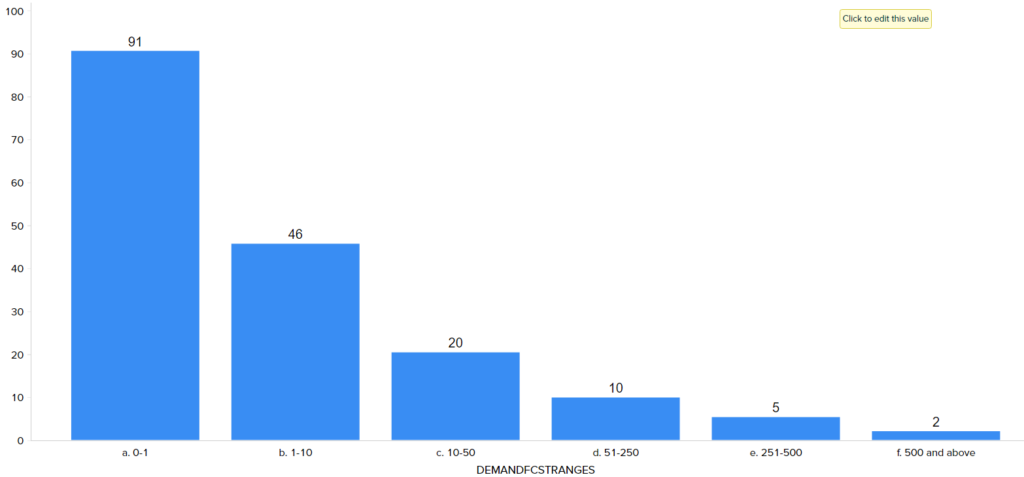Happy Friday and Welcome Back to the Series!
 We’ve been talking about the 7 components it takes to get demand planning right. Today it’s Step #3, Order Cycle Optimization. Before we get started, we need to get something off our chest…
We’ve been talking about the 7 components it takes to get demand planning right. Today it’s Step #3, Order Cycle Optimization. Before we get started, we need to get something off our chest…
The Golden Rule of Order Cycle Optimization is that “Undisciplined Buying Multiples Can Fill Warehouses.” So let’s hone in on your buying multiples strategy. With the availability of advanced inventory analytics tools for buying multiples, order cycle optimization is a super low-effort/high-payoff inventory reduction strategy you need right now.
A Quick 10% Inventory Reduction is Possible with Proper Order Cycle Analysis
Inventory reduction can come from surprising sources. If you are looking for strategy to reduce inventory 10% or greater, buying multiples is probably not the first place you think to look. However, this essential element has been flying under the radar for years, and deserves serious attention.
Today’s advanced supply chain analytics are painting a clear picture of financial inventory opportunities. Your buying multiples strategy could be the key to freeing up significant capital for your business.
Buying Multiples and Order Cycle Strategy
The buying multiples component of your purchasing process has great influence on the order cycle. For items with high buying multiples, multiples can actually overtake the supplier order cycle and become the item’s actual order cycle.
For this reason, strong inventory analytics are required to see the true picture of your order cycle strategy and how it is influenced by your buying multiples. You might be carrying much more cycle stock than you planned.
Smart Strategist or Lazy Buyer?
The way an Analyst handles buying multiples says a lot about their character, but even more about the profitability of your organization. Does your team’s buying multiple strategy look like Analyst 1 or Analyst 2?
Analyst 1: Smart & Savvy
 The intelligent Inventory Analyst will keep inventories low and supplier lines balanced. The warehouse will appreciate the smart buying multiples, and will keep their floors and bins clear with ample space for storage and movement.
The intelligent Inventory Analyst will keep inventories low and supplier lines balanced. The warehouse will appreciate the smart buying multiples, and will keep their floors and bins clear with ample space for storage and movement.
This is a cascading strategy where the buying multiples in days are logically lower as you move from slow- to fast-movers.
Analyst 1’s Approach to Days of Supply
- The fast-moving items with the most inventory have buying multiples equal to low days of supply. This ensures that most of the inventory buys to a similar order-up-to level during replenishment.
- The medium- and slow-moving items have higher buying multiple days. However, they have lower inventory and sales dollars, so the impact is not dramatic.
- This overall strategy is a smart, cascading strategy. The inventory investment remains low. During replenishment, the A-items are not purchased high on the depletion graph. The line remains balanced.
Analyst 2: Loaded & Lazy
This ‘round-way-up’ strategy for buying multiples will keep inventories high and supplier lines unbalanced. The warehouse might request that you buy in the largest multiple, but it will inflate your financial investment. And they probably don’t realize that it actually limits their warehouse space.
This is a flat strategy where the buying multiple in days are all very similar. Unfortunately, those high-forecast items make up the largest amount of inventory.
Every additional day of supply resulting from high buying multiples tightens the cash position of the company.
The strategy results in an easier workload with fewer orders, but the increase in inventory raises expenses and leaves little cash available.
Analyst 2’s Approach to Days of Supply

- The strategy has a flat, non-cascading approach. The high-inventory A-items have the same buying multiple days as the B and C items.
- For too many items, the buying multiple will become the order cycle for the item.
- You might believe that your inventory is being replenished with a supplier set to a 14-day order cycle; but in the graph above, you can see the items are all being replenished to a supply of 20+ days.
- Your lines will not experience a balanced time-supply. It will be difficult to order the line up to the same order-up-to level in days, as they all have to adhere to a different buying multiple in days.
- “Loaded & Lazy” Analyst 2 will live with excessive inventory at all times.
The Process
1. Understand the definition: Buying multiples are rounding multiples.
Buying multiples is part of Order Cycle Optimization, but it is activated during replenishment in Step #7, Order Validity Analysis. We’ll get to that step later.
Once you determine how much you need to buy, you make a final adjustment to the quantity to adhere to the required or chosen buying multiple.
2. Gather the data and choose the best buying multiple
The buying multiple decision is made for each item, separately, at each location.
 You start by gathering all options. Perhaps you can buy in eaches, but you have the option of cases, layers or pallets. It is important to always know the possibilities that your suppliers offer for each item.
You start by gathering all options. Perhaps you can buy in eaches, but you have the option of cases, layers or pallets. It is important to always know the possibilities that your suppliers offer for each item.
Establishing smart buying multiples is too often viewed as a project performed every few years, rather than an ongoing process. This needs to change.
3. Consider buying multiples during merchandising-mix decisions
For your slow-moving items, a required buying multiple might equate to 6-months’ supply or more. For many of these items, your required buying multiple might eliminate any opportunity to make a profit on the item. The inventory operating expense can be greater than the margin.
You can fight a required buying multiple with your supplier, or possibly look for central stocking opportunities. However, there are times where the buying multiple requirement guides you to a decision of making the item ‘non-stock’.
4. Use a supply chain analytics solution to coordinate options
Advanced inventory planning tools provide intelligent logic. You can enter the smart buying multiple of a layer, but if your needs occasionally get within striking distance of the pallet, it will make the jump. This eliminates the common pitfall of setting buying multiples too high.
You might be lazy IF…
Here are 3 symptoms that you are too much like Analyst 2 “Loaded & Lazy”

The red lines show that items are guided by their high buying multiples and all end up at different levels. They are high on the depletion graph and out of balance
1: You might be lazy IF… The Buying Multiple becomes the Order Cycle too often.
Analyst 2 believes their supplier order cycles are driving their replenishment, but for way too many items, the buying multiple becomes the true order cycle, and it is much higher. This drives inventory up.
2: You might be lazy IF… Inconsistent Buying Multiple days throws the line out of balance.
When a line is replenished, and your strategy is trying to buy everything to the same order-up-to-level, it will fail. As shown by the red lines above, the items are guided by their high buying multiples and all end up at different levels. They are high on the depletion graph and out of balance.
3: You might be lazy IF… You are topping off high-inventory A-items.
Because they are out of balance, many items, including many A-items that sit just a few days below the order-up-to-level with very little need, are replenished back up and forced to go weeks beyond the desired OUTL.
These high inventory items are being ‘topped off’ and never deplete down to the lower level, where they could be living.
That’s where results happen
Lazy Analyst 2 can likely reduce their inventory 10-20% or more if they take on the “Smart & Savvy” buying multiples strategy of Analyst 1.
Challenge yourself on these key numbers

Savvy teams know their numbers. Inventory analytics paint clear pictures of your inventory investment. These pictures tell stories that lead to action. Here are some key analytics numbers to help with order cycle optimization and smart buying multiples:
- What is the average Buying Multiple in Days of your top 200 items? Converting each item’s buying multiples to days’ supply is a key first step in creating an intelligent strategy.
- How many items have a Buying Multiple in Days that is greater than its Order Cycle? What is that answer for your top 5 suppliers? It is possible that your buying multiples are actually driving your replenishment more than your order cycles?
- What criteria do you use to establish the Buying Multiple for each item? How is the decision made? Do you use whatever the supplier suggests, or is there financial analysis using the demand forecast, item cost, carrying cost and acquisition cost?
- Does your Buying Multiple strategy offer multi-level flexibility? In other words, can you set the multiple to a layer, but if the needs of an order are close to the pallet, then automatically make the jump?
- Do you know all of your options? Do you have a solid process of knowing the buying multiple size options from your suppliers so that you have the information for constant analysis and action?
Aggregate Values
Inventory Scorecards now display Buying Multiple Aggregate values. Start with the following 3 aggregate values. Aggregate values are dollar and forecast weighted.
- Supplier Order Cycle (Aggregate): The average weighted Supplier Order Cycle for your entire inventory.
- Buying Multiple Days (Aggregate): The average weighted Buying Multiple in Days reveals how much your buying multiple settings are influencing your replenishment and investment.
- Effective Order Cycle (Aggregate): The end-result average weighted Order Cycle. This is the number of days of days you replenish on average across all items.
Though each item starts with its suppliers’ order cycle, the combination of the buying multiples and economics of slow-moving, low-cost items will result in a higher effective order cycle.
Order Cycle Best Practices
Take a look at the Inventory Scorecards of Analyst 1 and Analyst 2. In the end, Analyst 1 replenishes 16 days, while Analyst 1 replenishes 24 Days.

Analyst 1 has a more efficient financial strategy. They will enjoy lower inventory year-round and more balanced orders. The items in their lines will come due to be replenished together in harmony much more often.
Best practices
Selecting intelligent buying multiples today will lead to financial success.
Choosing the smartest multiple is a combination of securing the lowest inventory investment combined with the most efficient buying and receiving costs.
A best-in-class supply chain analytics solution has tools to help you make these decisions. It points out where your ‘required’ buying multiples are stealing margins and forcing the item to be unprofitable.
These solutions help adjust the chosen buying multiple as you go in and out of seasons, and they determine when to jump to the next multiple size during daily replenishment.
Inventory teams can move from a gut-feel buying multiple strategy to an intelligent financial strategy very quickly with the right order cycle analysis tools. Let smart and savvy be your path to extraordinary inventory reduction.
Read Part 4: Service Level Management
Read this series from the beginning:
















